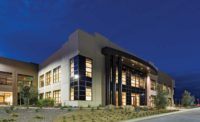Home Depot Distribution Center
Ogden, Utah
Best Project
Owner: Boyer Co.
Lead Design Firm: GSBS Architects
General Contractor: Big-D Construction
Structural Engineer: Dunn Associates Inc.
Civil Engineer: Great Basin Engineering
MEP Engineer: Colvin Engineering Associates Inc.
Interiors Architect: MacGregor Associates Architects
Key Subcontractors: Boman & Kemp; Daw Construction Group; Golder Acoustics; Landscape Specialties Inc.; Leon Poulsen Construction; Lynn Woodward Electric; Meridian Steel Erectors; Redd Roofing Co.
The Ogden facility is Home Depot’s first drive-through warehouse, which allows for safer truck loading and unloading without drivers having to work around warehouse employees or products. Work on the facility started in the fall, so tents were erected to keep snow and moisture away from the panels, allowing the team to work through the wet winter months. The distribution center has a 92-ft-long drive-through bay, a work area so large that there was almost no laydown area for the concrete tilt-up panels that comprise the building’s core and shell. Each of the 35 panels weighs anywhere from 80,000 to 120,000 lb; some have openings as large as 400 sq ft. The bay also featured a trench drain, which required a sloped floor on either side. Placing the concrete accurately for the floor slope was a test of craftsmanship.
An exterior rail line and an interior rail spur move products efficiently in and out of the building’s 150,000 sq ft of storage space. The dual rail system allows workers to unload box cars quickly and stack materials either inside or outside, as appropriate, for faster shipment to Home Depot stores. The rail lines were planned so they would not disrupt operations at adjacent rail lines, would not impede work at the distribution center or compromise the safety of workers. Crews orchestrated their tasks safely to erect the heavy panels around several obstacles.
Although the team also faced numerous challenges with weather, consistent efforts with safety and training made a difference. In more than 38,000 hours of work, the project had zero OSHA recordables and no lost-time accidents.
Related Article: ENR Mountain States Best Projects 2018: A Healthy Mix of Public and Private Projects Garner This Year's Top Awards







Post a comment to this article
Report Abusive Comment